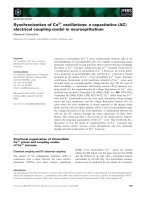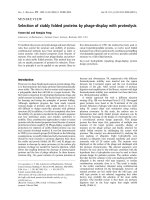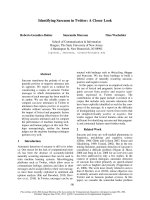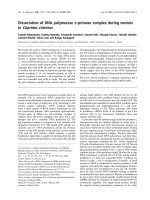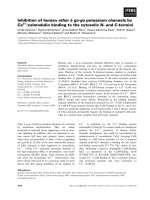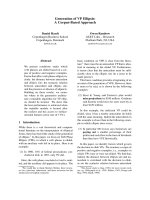Báo cáo khoa học: Selection of peptides inhibiting a b-lactamase-like activity docx
Bạn đang xem bản rút gọn của tài liệu. Xem và tải ngay bản đầy đủ của tài liệu tại đây (196.77 KB, 7 trang )
Selection of peptides inhibiting a b-lactamase-like activity
Anne-Sophie Yribarren, Daniel Thomas, Alain Friboulet and Be
´
range
`
re Avalle
Ge
´
nie enzymatique et cellulaire, UMR 6022 CNRS, Universite
´
de Technologie de Compie
`
gne, France
A library of random peptide sequences was used to select
peptides that inhibit an anti-idiotypic catalytic Ig, immuno-
globulin (IgG) 9G4H9, with a b-lactamase-like activity. This
library displays cyclic heptapeptides on the surface of bac-
teriophagesandrepresentsacollectionofupto4.5· 10
9
peptides. The first selection step aimed at enriching the lib-
rary in species that bind to the whole Ig molecule. The sec-
ond step was to discriminate peptides that bind to part of the
molecule other than the active site. Selected peptides were
then screened by surface plasmon resonance analysis. Those
displaying measurable K
d
values were assayed for their
ability to inhibit the catalytic Ig.
Keywords: catalytic antibodies; anti-idiotypy; b-lactamase;
phage display library; constrained peptide.
The elucidation of the rules governing the relationships
between the structure of proteins and their function is
currently one of the major challenges. In this field,
combinatorial approaches offer tremendous possibilities.
The main requirement is to be able to sort, from the
engineered diversity, mutants or new compounds according
to the required function.
Random peptide libraries are inexhaustible sources of
small compounds likely to bind targets such as enzymes,
antibodies, receptors or even DNA (recently reviewed in [1]).
Combinatorial libraries can be chemically synthesized or
displayed on engineered bacteriophages, as proposed by
Smith’s pioneer studies from the 1980s [2,3]. The use of
phages allows one to work on huge libraries. It allows rapid
isolation of the sequence of the selected compounds, leading
to the identification of residues involved in the interaction [4].
We have developed previously an original approach to
generate catalytic proteins, other than enzymes, yielding
valuable information about structure–function relationships
[5–8]. According to Jerne’s concept [9], some of the anti-
idiotypic Igs generated by immunization by antibodies may
mimic some of the antigenic properties and functions. These
antibodies are said to be the Ôinternal imagesÕ of the original
antigens. We applied this theory to the elicitation of a new
catalyst, displaying a b-lactamase-like activity. Starting
from b-lactamase, we have produced an inhibitory active
site-specific Ig (Ab1), capable of inducing anti-idiotypic Igs
(Ab2) displaying the model-like catalytic activity [10]. We
have also demonstrated that the b-lactamase-like Ig (IgG
9G4H9) is a true anti-idiotypic Ig by generating polyclonal
Ab3, which recognizes b-lactamase [7]. The Ab2 catalytic Ig
would then be of valuable help to elucidate on the one hand
some structure–function relationships associated with
b-lactamase activity and, on the other hand, the mecha-
nisms governing the transfer of catalytic information
throughout the idiotypic network.
In this context, we proposed to achieve the selection of
peptide inhibitors, specific for the activity observed in the
b-lactamase Ig. We have carried out a two-step selection
procedure from a random library of constrained peptides
displayed on bacteriophages, based on exclusive affinity for
theIgactivesite.
Materials and methods
Production and purification of IgG 9G4H9
Hybridomas were grown in Dulbecco’s Modified Eagle’s
Medium (Eurobio) containing 10% (v/v) fetal bovine
serum, 1% (w/v)
L
-glutamine 200 m
M
, 1% (w/v) pyruvate
100 m
M
,50UÆmL
)1
penicillin and 50 lgÆmL
)1
strepto-
mycin. Harvested cells were expanded by injection into
pristane (2,6,10,14 tetramethyl pentadecan)-treated BALB/
C mice. Resulting ascitic fluids were collected 10 days later,
centrifuged at 350 g for 5 min at 4 °C and stored at )20 °C.
Purification of monoclonal Igs was carried out on a
HiTrap rProtein A column (Amersham Pharmacia Biotech)
that presents a high affinity for the constant region of IgGs
of isotype 2b, such as 9G4H9. The binding buffer contained
50 m
M
Tris/HCl,pH9,and0.2
M
NaCl. The elution buffer
was obtained from Biorad and was used according to the
manufacturer’s instructions. The IgG-containing fractions
were dialysed overnight against a 0.1
M
sodium phosphate
buffer, pH 7.4. After concentration by centrifugation at
7000 g for 45 min on 30 kDa Microsep
TM
filters, IgG
concentration was determined by the bicinchoninic acid
assay (BCA, Sigma). The purity of the preparation was
estimated by silver-stained 8% (w/v) polyacrylamide gel
electrophoresis.
Amplification and purification of phage peptide libraries
The random cyclic heptapeptides library (named CX
7
C)
was supplied by E. Koivunen, Dept of Biosciences, Division
Correspondence to B. Avalle, Ge
´
nie enzymatique et cellulaire,
UMR 6022 CNRS, Universite
´
de Technologie de Compie
`
gne,
BP 20529, 60205 Compie
`
gne Cedex, France.
Fax: + 33 3 44 20 39 10, Tel.: + 33 3 44 23 44 12,
E-mail:
Abbreviations: TU, transforming units; SPR, surface plasmon
resonance; BLIP, b-lactamase inhibitory protein.
(Received 6 March 2003, revised 15 April 2003, accepted 6 May 2003)
Eur. J. Biochem. 270, 2789–2795 (2003) Ó FEBS 2003 doi:10.1046/j.1432-1033.2003.03651.x
of Biochemistry, University of Helsinki, Finland [11]. The
library was amplified by infection of mid-log phase
Escherichia coli cells by 3.10
10
of phage transforming units
(TU) for 30 min, without shaking, at 37 °C. The infected
bacteria were then grown overnight, shaken at 37 °Cin1L
Luria-Bertani medium containing 20 lgÆmL
)1
tetracycline.
The amplified phages present in the culture supernatant
were precipitated overnight at 4 °C by adding 20% (v/v) of
20% polyethylene glycol 8000, 2.5
M
NaCl (PEG/NaCl).
Phages were then pelleted by centrifugation at 10 000 g for
45 min at 4 °C, suspended in 10 mL deionized water and
filtered through a 0.45 lm filter unit (Millipore). The phages
were reprecipitated in PEG/NaCl for 1 h at 4 °C. The
library was finally recovered in 1 mL Tris-buffered saline
(TBS), pH 7.5, containing 50 m
M
Tris/HCl and 150 m
M
NaCl. The library was stored at )20 °C.
Titration of the library was performed by infection of
mid-log phage E. coli bacteria by dilutions of phages for
30 min at 37 °C without shaking. One hundred microlitres
were then plated on solid Luria–Bertani agar plates
containing 20 lgÆmL
)1
tetracycline. The plates were incu-
bated overnight at 37 °C and visible clones counted.
Solid phase selection procedures
Experimental concentration conditions are summarized in
Table 1.
Positive selection. Maxisorb plates (96 wells) were pur-
chased from Nunc. The panning method was derived from
Parmley and Smith [3]. Unless otherwise stated, each step of
the procedure was followed by three washings of the plates
in TBS containing 0.1% Tween 20 (TTBS) and plates were
incubated1hat37°C without shaking.
The microplates were coated with 100 lLof2.5lgÆmL
)1
rat anti-(mouse IgG) in 0.1
M
carbonate buffer pH 8.6.
Wells were then saturated with 100 lL of 2% milk in NaCl/
Tris (MTBS) (w/v), and 100 lL of 1–10 lgÆmL
)1
IgG
9G4H9 in NaCl/Tris were added to the saturated wells.
Between 5 · 10
10
and 2.5 · 10
11
TU were first incubated
for 10 min at 37 °C in MTBS, to avoid the binding of
displayed peptides to milk proteins. This solution was then
transferred to the plate and incubated for 2 h at 25 °C. This
step was followed by 10 TTBS washings, each washing
lasting at least 5 min. The bound bacteriophages were
eluted from the plates by a 10 min incubation at room
temperature with a solution containing 0.1
M
HCl adjusted
at pH 2.2 by the addition of solid glycine. The pH of the
collected phage solution was neutralized by 11% of 2
M
Tris
(v/v).
The enrichment of the starting library in phage specific
for the IgG was followed by titration of the solutions before
and after each round of selection. This is expressed as the
following ratio: TU at round (n)/TU at round (n)1).
After each round of selection, eluted phage were ampli-
fied by infection of 20 mL mid-log phase bacteria as
described below, then used for the subsequent round.
Negative selection. This selection procedure was derived
from the positive one. The steps and washings were the
same, but the IgG 9G4H9 was exposed to contact with
penicillin G under conditions described previously [12]. The
covalent complex thus formed was added to saturated wells.
The bacteriophage issued from the positive selection that
were not retained on this complex, i.e. that are not specific
for the active site, were directly recovered and amplified for
further rounds of selection.
Phage ELISA
Unless otherwise stated, wells were filled with 100 lLofthe
indicated solutions, plates incubated for 1 h at 37 °Cand
each step followed by three washings in TTBS.
One microgram IgG 9G4H9 in 0.1
M
carbonate buffer,
pH 8.6, was coated on a Maxisorb microplate. Wells were
saturated by MTBS. Variable amounts of bacteriophage,
from 5 · 10
7
to 5 · 10
10
TU per well, were then added and
incubated for 2 h in MTBS at room temperature. After 10
washes in TTBS, bound phage were detected by 1 lganti-
M13 horseradish peroxidase-conjugated monoclonal anti-
bodies (mAbs) (Amersham Pharmacia Biotech). The
fixation of labelled antibodies was measured by the
addition of 0.3 mgÆmL
)1
azino ethylbenzthiazoline sulfonic
acid (Sigma), a substrate of peroxidase, in 50 m
M
citrate
buffer, pH 5, with 0.05% H
2
O
2
. Absorbance was read at
405 nm.
Sequencing of phage DNA
Oligonucleotides were purchased from Oligo Express and
DNA sequencing was performed by Genome Express (both
Paris, France).
The DNA peptide inserts of individual plated clones
issued from rounds of selection were amplified by PCR
performed on an Eppendorf thermocycler. A precycle at
94 °C for 10 min and 35 cycles of denaturation at 94 °Cfor
1 min, AB 348 and AB 349 primers annealing at 54 °Cfor
1 min and elongation at 72 °Cfor1.5min.Taq DNA
polymerase was purchased from New England Biolabs.
The forward primer AB 348, 5¢-TTAGCAAAACCTC
ATACAGAA-3¢, and the backward primer AB 349,
5¢-GATGCTGTCTTTCGCTGCTGAG-3¢,wereusedfor
DNA amplification. The M13 forward primer,
5¢-ATTCACCTCGAAAGCAAGCTG-3¢,wasusedfor
sequencing.
Table 1. Experimental conditions of selection. Concentrations of rat
anti-(mouse IgG), IgG 9G4H9 and phages from the library CX
7
Care
indicated from the first to the sixth round of positive selection on IgG
9G4H9 and for the two rounds of negative selection on IgG 9G4H9
complexed to its suicide substrate penicillin G. The terms in brackets
indicate the name of the round used in the text.
Catalytic IgG 9G4H9
(lgÆmL
)1
)
CX7C
library (
M
)
1 (R 1) 2.5 10 8.3 · 10
)8
2 (R 2) 2.5 10 1.66 · 10
)8
3 (R 3) 2.5 1 1.66 · 10
)8
4 (R 4) 2.5 1 1.66 · 10
)8
5 (R 5) 2.5 1 1.66 · 10
)8
6 (R 6) 2.5 1 1.66 · 10
)8
1 (NS 1) 2.5 1 1.66 · 10
)8
2 (NS 2) 2.5 1 1.66 · 10
)8
2790 A S. Yribarren et al.(Eur. J. Biochem. 270) Ó FEBS 2003
Synthetic peptides
Several selected peptides displayed on the surface of
bacteriophages were synthesized in their soluble form. The
cyclic and biotinylated peptides containing 18 amino acids
were purchased from Eurogentec (Angers, France) and
designed with the two N-terminal residues belonging to the
pIII protein of the bacteriophages. These were followed by
two cysteines flanking the peptide sequence. The C-terminal
sequence corresponds to the biotin moiety (linked to the
lysine of Gly-Ala-Ala-Gly-Ala-Glu-Lys). The sequence of
free peptides is thus: NH
2
GACX
1
X
2
X
3
X
4
X
5
X
6
X
7
CGAA
GAEKCONH
2
,withX
n
corresponding to the random
residues of the displayed peptide. Synthesis was performed
under oxidative conditions, to preferentially form the
cyclizing disulfide bond. Between 1 and 3 m
M
of peptide
stock solutions were stored at )20 °C and prepared in water
or in 50 m
M
acetic acid solution according to their
hydrophobic features.
Surface plasmon resonance (SPR) analysis
SPR analysis is performed with a BIAcore X (Biacore AB,
Sweden). Streptavidin coated chips and running buffer HBS
pH 7.4 containing 10 m
M
Hepes, 0.15
M
NaCl, 3.4 m
M
EDTA and 0.005% surfactant P20, were from Pharmacia
(Uppsala, Sweden).
Immobilization of the biotinylated ligands (40 lgÆmL
)1
in HBS) on the surface of SA chips was done by injecting
40 lL at a flow rate of 5 lLÆmin
)1
.TheK
d
values were
determined by injecting 40 lL of Ig solutions ranging from
100 to 600 n
M
in HBS at a flow rate of 7 lLÆmin
)1
.The
regeneration of the surface was carried out by injecting
6 lLof50m
M
HCl. Curve fitting and kinetic data
analyses were carried out using
BIAEVALUTION
3.0.1
software.
Kinetic assays
The catalytic activity of 2 l
M
IgG 9G4H9 was measured
spectrophotometrically by following the hydrolysis of
ampicillin at 232 nm in 0.1
M
phosphate buffer (pH 7.4).
IC
50
values were determined on the basis of the residual
activity of 9G4H9 after a 20 min incubation with different
amounts of peptides or phage.
Results
Selection of peptides binding to the Ig
The library (CX
7
C) of constrained heptapeptides displayed
on the surface of bacteriophages was kindly provided by
E. Koivunen [11]. Its diversity extends to 4.5 · 10
9
different
combinations. During the amplification and propagation of
phage, we always ensured that the whole diversity was
expressed by titrating the purified phage.
The first step of the selection procedure was performed on
plates coated with monoclonal antibodies directed against
the constant region of mouse IgGs, as 9G4H9. The active
site within the variable region of 9G4H9 should thus be
favorably exposed to the library. We also confirmed that
9G4H9 activity was fully maintained in TBS.
From the third round, the selection pressure was
increased by reducing the concentration of 9G4H9 from
10 to 1 lg (Table 1). The peptides selected from this third
round should therefore display improved affinities for the
Ig. After five rounds, the yield of specific peptides retained
on 9G4H9 was 1000-fold higher than in the original library.
As shown in Fig. 1 (abscissa R 1 to R 5), a significant
enrichment of specific peptides was obtained from the
second round. The signals measured in phage ELISA from
the first to the sixth round (Fig. 2, abscissa R 1 to R 6)
indicate that the affinity of the pool of selected peptides
progressively increases.
We randomly chose 27 isolated clones from the fifth
round, which were amplified and sequenced. These peptides
could then be gathered in 10 families according to their
amino acid content (Table 2). Within each family, the
peptides share the same sequence. The analysis of the
Fig. 1. Enrichment of the CX
7
C library in phages recognizing the target.
The yield of recovered TU corresponds to the ratio of phages collected
at the end of each round over phages inserted in this round. Open bar:
Phages recovered during the positive steps of the selection (rounds R1
to R5) carried out on IgG 9G4H9. (Grey bar): Phages recovered after
the negative selection (rounds NS 1 and NS 2), i.e. with IgG 9G4H9-
penicillin G covalent complex as a target.
Fig. 2. Phage ELISA on enriched CX
7
C library at each round of
selection. Values of absorbance at 405 nm correspond to the fixation of
5 · 10
10
M
TU to 1 lg of immobilized IgG 9G4H9, revealed by anti-
M13 horseradish peroxidase-conjugated mAbs in the presence of azino
ethylbenzthiazoline sulfonic acid. Open bar represents the phages of
the positive step of selection (R 1 to R 6) (grey bar) those of the
negative step (NS 1 and NS 2), and black bar the original library.
The background signal corresponds to the fixation of CX
7
Ctothe
microplate not coated with IgG 9G4H9. Standard deviations are cal-
culated from three independent experiments.
Ó FEBS 2003 Peptides inhibiting a catalytic antibody (Eur. J. Biochem. 270) 2791
aligned sequences, notably the frequency of amino acids at
each position, provided two pieces of information. First, the
three central residues X
3
X
4
X
5
(notation as in Synthetic
peptides section) are mostly hydrophobic (more than 59%
of the considered residues). Trp is present in 19% of these
three residues, Leu in 11% and Met and Phe in 7%. Second,
the Pro is present in 18.5% of the peptide sequences.
Binding of the peptides displayed on phages to IgG
9G4H9 was measured by a monoclonal phage ELISA.
Clones from the fifth round of positive selection were
assayed in addition to the original library CX
7
C (Fig. 3).
They all showed a significant capability to bind the Ig. The
library gave a weaker ELISA signal than isolated clones that
have encountered five rounds of selection because it
contains many phage that are not specific for the Ig. This
first positive step of selection is consequently efficient,
because it allows one to obtain peptides that significantly
bind to the target.
Selection of peptides binding to the Ig active site
The second step of the procedure, called negative selection,
was carried out on phage from the fifth round of positive
selection. This step was applied using IgG 9G4H9 whose
catalytic site was covalently blocked by penicillin G.
Previous studies on 9G4H9 mechanism have shown that
hydrolysis of penicillin G by the Ig behaves as a suicide
substrate mechanism by rapidly forming a covalent irre-
versible complex [12]. This property was thus exploited to
select peptides with inhibitory features. Peptides that both
(a) bind to the Ig and (b) do not bind to the Ig-suicide
substrate complex should be specific for the Ig active site.
They were then amplified prior to another round of negative
selection. Figure 1 (abscissa NS 1 and NS 2) shows that the
two rounds of negative selection were efficient in enriching
the yield of peptides not retained to the Ig inactivated by
penicillin G, i.e. specific for the active site. The phage
ELISA carried out on the free IgG 9G4H9 (Fig. 2, abscissa
NS 1 and NS 2) gave significant signals, meaning that some
of the peptides isolated from the two negative rounds
remain specific for the Ig. The results were compared with
those of the sixth round of positive selection (R 6): no gain
of affinity for this round of selection was observed whereas
the affinity was improved for the two rounds of negative
selection. However, no significant difference could be
observed between the first and the second round of negative
selection in our experimental conditions. On the one hand,
there is an increase in the yield of specific peptides recovered,
but on the other hand the affinity remains the same.
Nevertheless, increasing the selection pressure by decreasing
the amount of Ig linked to its substrate should not be
efficient in improving affinities because, for negative selec-
tion, only peptides that are not retained are collected.
We isolated and sequenced clones from the two rounds of
negative selection. Peptides issued from the negative selec-
tion display a high percentage of Trp residues (13%)
(Table 3). Three families of peptides previously sequenced
at the fifth round of positive selection were retrieved in the
first round of negative selection. The three families of
peptides have a Pro at their C-terminal (X
6
or X
7
), and they
contain a Trp. More than 38% of the residues are
hydrophobic. Two families (2 and 5) were also retrieved in
the second round. The peptides of these two families
Table 2. Amino acid sequences of the 10 families of the 27 selected
clones. Clones isolated from the five first rounds of positive selection
were isolated and sequenced.
Family Amino acid sequence
1 WVGIARD
2 WDTGDPE
3 IVNGIGF
4 TQNMRSA
5 YHFLWGP
6 EGWLMLM
7 TGWREMF
8 HVWFPES
9 LPWLGPR
10 GWVGQLG
Fig. 3. Phage ELISA on clones isolated from the fifth round of positive
selection. The name of the clone (F
x
) corresponds to the family
reported on Table 2 to which belongs the clone. Open bar corresponds
to the signal given by isolated clones and black bar corresponds to the
signal obtained with the library CX
7
C. Absorbance values at 405 nm
are the means of three identical experiments carried out independently.
Error bars indicate standard deviations.
Table 3. Sequences of clones issued from the negative selection.
Family
(positive
selection) First round Second round
Name of the free
corresponding
peptide
Family 2 WDTGDPE
a,b
WDTGDPE
a,b
Pep 96
Family 5 YHFLWGP
a,b
YHFLWGP
a,b
Pep 90
Family 9 LPWLGPR
a
Pep 91
GPHWWGY Pep 92
WGHYWWQ Pep 93
ERDKHEG Pep 94
ERLSPSF Pep 95
GWVGQLG
SAKYALW
RSQGTLE
PLDLLPL
a
Sequences that were already identified after the fifth round of
positive selection.
b
Sequences that are retrieved in both rounds of
negative selection.
2792 A S. Yribarren et al.(Eur. J. Biochem. 270) Ó FEBS 2003
appeared clearly as good candidates for the inhibition of the
catalytic activity shown by IgG 9G4H9.
Analysis of binding properties by surface plasmon
resonance
Phage ELISA appeared to be an efficient qualitative assay.
However, it cannot be used to measure accurate K
d
values
because the affinity of the Ig for phage particles probably
takes part of the signal. We thus worked on synthetic free
cyclic peptides.
The free structures corresponding to the sequences of
seven negatively selected peptides (Table 3), displaying the
best signals in phage ELISA, were synthesized according to
the following feature: NH
2
GACX
n
CGAAGAEKCONH
2
,
with X
n
corresponding to the residues of the displayed
peptide. The synthesis was performed under oxidative
conditions in order to induce the formation of the disulfide
bond by association of the two bordering cysteines, thus
leading to a cyclic structure. This cyclic structure is flanked
at the N-terminal end by two residues belonging to the pIII
phage coat protein and at the C-terminal by a biotin moiety.
For SPR analysis, peptides were immobilized on strept-
avidin-coated chips via their biotin moiety. The selected
peptide was thus correctly exposed to the circulating
analytes. The signal correponding to the immobilization
reaches 150–180 response units for each of the seven
peptides. Binding of the rat anti-mouse IgG that was coated
in the selection procedure was assayed as the background
control. Kinetic parameters and K
d
values were determined
from sensorgrams and are reported in Table 4. IgGs being
dimeric proteins, the calculations were extrapolated from a
bivalent analyte model. Among the seven assayed peptides,
three of them (Pep 91, Pep 93, Pep 95) do not significantly
bind to IgG 9G4H9 under SPR experimental conditions.
Among the four other peptides, three (Pep 92, Pep 94 and
Pep 96) displayed a weak binding ability not easily meas-
urable in SPR conditions, and one of them (Pep 90) revealed
a high affinity for the Ig, with a K
d
value of 7.4 · 10
)8
M
(Fig. 4). As shown on the figure, the experimental data fit
the theoretical plot. We verified the absence of mass transfer
interference by assaying several analysis conditions, notably
by varying the flow rate of the circulating analyte.
Inhibition of the 9G4H9 b-lactamase activity
Pep 90 was tested for its inhibition properties of 9G4H9
catalytic activity. Kinetics were carried out using peptide
concentrations from 0 to 180 l
M
. Pep 95 was assayed as a
negative control because it presents the same biochemical
properties as Pep 90, notably its pI, but has a low affinity
for 9G4H9. The inhibitory capabilities of Pep 90 were
investigated by measuring the residual b-lactamase activity
of the IgG 9G4H9 after 20 min of incubation with various
amounts of peptide (Fig. 5). A half inhibitory concentration
(IC
50
) can be calculated from this inhibition plot. For
9G4H9, the IC
50
¼ 9.10
)5
M
. No inhibition effect could be
measured with Pep 95. This indicates that the inhibitory
effect is undoubtedly due to the selected sequence and not to
biotin or phage pIII moieties.
Strynadka et al. have previously reported the character-
ization of a 165-residue b-lactamase-inhibitor protein, BLIP
(K
i
¼ 0.3 n
M
) [13,14]. We tested the inhibition of the
b-lactamase activity of the anti-idiotypic Ig using a
bacteriophage displaying BLIP on its surface, engineered
and provided by T. Palzkill, Dept of Molecular Virology
and Microbiology, Baylor College of Medicine, Houston,
TX, USA [15]. BLIP displayed on phage were found to
inhibit the IgG with an IC
50
around 10
)5
M
. We then carried
out a competitive ELISA assay, derived from the previously
described phage ELISA, where IgG 9G4H9 was coated on
Table 4. Kinetic values and dissociation constants for seven selected
peptides. Measurements were performed by SPR analysis. BT, below
threshold; ND, not determined.
Peptide k
on
(
M
)1
Æs
)1
) k
off
(s
)1
) K
d
(
M
)
Pep 90 3.1 · 10
4
± 4.8 · 10
2
2.3 · 10
)3
±10
)4
7.4 · 10
)8
Pep 91 BT BT ND
Pep 92 6.9 · 10
3
± 6.8 · 10
1
4.1 · 10
)2
± 4.8 · 10
)3
5.9 · 10
)6
Pep 93 BT BT ND
Pep 94 4.6 · 10
3
± 4.5 · 10
2
5.2 · 10
)3
± 5.5 · 10
)4
1.1 · 10
)6
Pep 95 BT BT ND
Pep 96 4.8 · 10
3
± 7.1 · 10
1
1.2 · 10
)3
± 5.1 · 10
)5
2.4 · 10
)7
Fig. 5. Inhibition of IgG 9G4H9 b-lactamase activity by Pep 90.
9G4H9 (3.2 l
M
) was incubated with various concentrations of Pep 90
(0–180 l
M
) for 20 min at room temperature. The activity was revealed
with 1.8 m
M
ampicillin in phosphate buffer 0.1
M
pH 7.4 (grey bar).
Pep 95 (open bar) was used as a control from 0–100 l
M
.
Fig. 4. Sensorgrams corresponding to SPR analysis. Sensograms of
SPR analysis of the binding of Pep 90 (40 lgÆmL
)1
in HBS) immo-
bilized on SA chips, to various concentrations of IgG 9G4H9 from
156 n
M
to 468 n
M
, in HBS buffer, circulating at 7 lLÆmin
)1
.The
experimental data fit the theoretical plot.
Ó FEBS 2003 Peptides inhibiting a catalytic antibody (Eur. J. Biochem. 270) 2793
plates and incubated with BLIP on phage. The binding of
BLIP was measured by an anti-M13 peroxidase-conjugated
Ig, that gives a chromogenic signal in the presence of its
substrate. We added various amounts of free Pep 90, from 0
to 100 lgÆmL
)1
. The residual binding of BLIP was then
estimated (Fig. 6). Pep 90 was found to expel BLIP from
9G4H9 active site. This clearly indicates that BLIP and
Pep 90 share the same interaction site.
Discussion
The selection of inhibitory compounds is a real challenge
because biocatalysts are generally elaborate macromole-
cules. We have developed a procedure to obtain peptides
that on the one hand display a tight affinity for the
biocatalyst and, on the other hand, valuably inhibit a
b-lactamase-like activity shown by an anti-idiotypic cata-
lytic Ig. By this approach, we reduced the diversity of the
original library from more than one billion peptides to only
four, with one displaying the required function. Our method
isallthemoreefficientinthatthetarget,anIgG,isa
macromolecule of high molecular mass (approximately
150 kDa) thus displaying many potential interacting sites.
We have previously suggested that only a few residues (two
serines, one lysine and one glutamic acid) were involved in
the catalytic activity of the Ig; they are located on the light
chain and gathered together [12,16].
It was previously demonstrated that cyclic peptides
displayed on phage could favourably lead to ligands
presenting better affinities than linear ones [17]. However,
the main restriction in the development of procedures based
on phage display technology to obtain worthwhile com-
pounds is that the selected molecules are interesting only if
they retain their activity in their soluble form. Some authors
indicate that cyclic peptides are more likely to retain their
function once in free form than their linear counterparts
[18]. In our work, four peptides out of seven have retained
binding features once in soluble form.
The sequence of the inhibitory peptide Pep 90 Tyr-His-
Phe-Leu-Trp-Gly-Pro is mainly composed of central hydro-
phobic residues and contains a Pro in the C-terminal,
similar to most of the peptides selected against IgG 9G4H9.
This result allows the definition of a basic feature of
structures able to bind to this IgG active site. BLIP was
described to be an efficient inhibitory protein of b-lactamase
[13] and it was found to also inhibit IgG 9G4H9 with a
weaker IC
50
. The residues of BLIP that are involved in the
inhibition function of b-lactamase were identified [19,20] as
Ala-Ala-Gly-Asp-Tyr-Tyr, which form a hairpin. The
primary structures of this part of BLIP and Pep 90 are
different, and their tri-dimensional schemes cannot be
overlaid. Consequently, the selection procedures that we
have developed have led us to find a completely new
solution for the inhibition of a catalyst.
The ability of BLIP to inhibit IgG 9G4H9 is a crucial
point because it proves that the active site IgG 9G4H9 is the
real internal image of b-lactamase. The b-lactamase-like
catalytic information was then successfully transferred from
the enzyme to the abzyme throughout the idiotypic
pathway. The catalytic features of a biocatalyst, such as
activity and inhibition by elaborated molecules, can thus be
preserved by the immune system within the idiotypic
network. This opens routes towards the idea that auto-
immune diseases involving catalytic antibodies [21,22] might
have appeared because of the presence of abnormal
amounts of nonimmunogen molecules stimulating the
apparition of catalytic Igs.
The procedure developed is efficient for the selection of
inhibitory peptides even in the absence of any information
about the structure of the target. It is much less time-
consuming and less expensive than rationally designed
synthetic compounds. Indeed, b-lactamase is widespread
throughout the world and is considered to be a plague for
the treatment of infections by antibiotics [23]. Designing
new antibiotic molecules is a flourishing activity of medical
research nowadays. The in vitro selection of peptides able to
inhibit b-lactamase activity appears, consequently, as a
good alternative route to the rational design of small
molecules based on the knowledge of the targeted catalytic
mechanisms.
Acknowledgements
We are grateful to Drs Barbee and Koivunen for kindly providing the
peptide library and Dr Palzkill for giving its BLIP construction for the
expression on phage. We gratefully acknowledge the Picardie region
and ALTERNATECH for supporting A.S. Yribarren.
References
1. Azzazy, H.M.E. & Highsmith, W.E. Jr (2002) Phage display
technology: clinical applications and recent innovations. Clin.
Biochem. 35, 425–445.
2. Smith, G.P. (1985) Filamentous fusion phage: novel expression
vectors that displayed cloned antigens on the virion surface.
Science 228, 1315–1317.
3. Parmley, S.F. & Smith, G.P. (1988) Antibody-selectable fila-
mentous fd phage vectors: affinity purification of target genes.
Gene 73, 305–318.
4. Devlin, J.J., Panganiban, L.C. & Devlin, P.E. (1990) Random
peptide libraries: a source of specific binding molecules. Science
249, 404–406.
5. Avalle, B., Friboulet, A. & Thomas, D. (2000) Catalysis by anti-
idiotypic antibodies. Chem. Immunol. 77, 80–88.
6. Kolesnikov, A.V., Kozyr, A.V., Alexandrova, E.S., Koralewski,
F., Demin, A.V., Titov, M.I., Avalle, B., Tramontano, A., Paul, S.,
Fig. 6. Competitive ELISA for the binding to IgG 9G4H9. Phage BLIP
(10
11
TU) were incubated on 1 lg coated IgG 9G4H9. After 1 h
incubation at 37 °C, various amounts of Pep 90 (0–100 l
M
)were
added to wells. Absorbance values are related to the residual binding of
BLIP to IgG 9G4H9. The CX
7
C library and M13 were assayed to
evaluate the background binding signal. The standard deviations were
calculated from two separate experiments.
2794 A S. Yribarren et al.(Eur. J. Biochem. 270) Ó FEBS 2003
Thomas, D., Gabibov, A.G. & Friboulet, A. (2000) Enzyme
mimicry by the anti-idiotypic antibody approach. Proc.NatlAcad.
Sci. USA 97, 13526–13531.
7. Avalle, B., Thomas, D. & Friboulet, A. (1998) Functional
mimicry: elicitation of a monoclonal anti-idiotypic antibody
hydrolysing b-lactams. FASEB J. 11, 1055–1060.
8. Pillet, D., Paon, M., Vorobiev, I.I., Gabibov, A.G., Thomas, D. &
Friboulet, A. (2002) Idiotypic network mimicry and antibody
catalysis: lessons for the elicitation of efficient anti-idiotypic pro-
tease antibodies. J. Immunol. Methods 269, 5–12.
9. Jerne, N.K. (1974) Toward a network theory of the immune
system. Ann. Immunol. 125c, 373–389.
10. Avalle, B., Mistro, D., Thomas, D. & Friboulet, A. (1996) Poly-
clonal catalytic anti-idiotypic antibodies with b-lactamase activity.
Ann. NY Acad. Sci. 799, 172–175.
11. Koivunen, E., Wang, B. & Ruoslahti, E. (1994) Isolation of a
highly specific ligand for the alpha-5, beta-1 integrin from a phage
display library. J. Cell. Biol. 124, 373–380.
12. Lefe
`
vre, S., De
´
bat, H., Thomas, D., Friboulet, A. & Avalle, B.
(2001) A suicide substrate mechanism for hydrolysis of b-lactams
by an anti-idiotypic catalytic antibody. FEBS Lett. 489, 25–28.
13. Strynadka, N.C., Jensen, S.E., Johns, K., Blanchard, H., Page,
M., Matagne, A., Frere, J.M. & James, M.N. (1994) Structural
and kinetic characterization of a beta-lactamase-inhibitor protein.
Nature 368, 657–660.
14. Strynadka, N.C., Jensen, S.E., Alzari, P.M. & James, M.N. (1996)
A potent new mode of beta-lactamase inhibition revealed by the
1.7 A X-ray crystallographic structure of the TEM-1-BLIP com-
plex. Nat. Struct. Biol. 3, 290–297.
15. Huang, W., Zhang, Z. & Palzkill, T. (2000) Design of potent beta-
lactamase inhibitors by phage display of beta-lactamase inhibitory
protein. J. Biol. Chem. 275, 14964–14968.
16. De
´
bat, H., Avalle, B., Friboulet, A. & Thomas, D. (2000)
Structure-function studies of a new generation of catalytic protein:
an abzyme with a b-lactamase activity. Int. J. Biochromat. 5,
91–96.
17. Giebel, L.B., Cas, R.T., Milligan, D.L., Young, D.C., Arze, R. &
Johnson, C.R. (1995) Screening of cyclic peptide phage libraries
identifies ligands that bind streptavidin with high affinities.
Biochemistry 34, 15430–15435.
18. McLafferty, M.A., Kent, R.B., Ladner, R.C. & Markland, W.
(1993) M13 bacteriophage displaying disulfide constrained
microproteins. Gene 128, 29–36.
19. Rudgers, G.W., Huang, W. & Palzkill, T. (2001) Binding
properties of a peptide derived from beta-lactamase inhibitory
protein. Antimicrob. Agents Chemother. 45, 3279–3286.
20. Rudgers, G.W. & Palzkill, T. (2001) Protein minimization by
random fragmentation and selection. Protein Eng. 14, 487–492.
21. De
´
bat, H., Avalle, B., Chose, O., Sarde, C.O., Friboulet, A. &
Thomas, D. (2001) Overpassing an aberrant Vk gene to sequence
an anti-idiotypic abzyme with b-lactamase like activity that could
have a possible linkage with autoimmune disease. FASEB J. 15,
815–822.
22. Friboulet, A., Avalle, B., De
´
bat, H. & Thomas, D. (1999) A
possible role of catalytic antibodies in metabolism. Immunol.
Today 20, 474–475.
23. Helfand, M.S. & Bonomo, R.A. (2003) Beta-lactamases: a survey
of protein diversity. Curr. Drug. Targets. Infect. Disord. 3, 9–23.
Ó FEBS 2003 Peptides inhibiting a catalytic antibody (Eur. J. Biochem. 270) 2795


